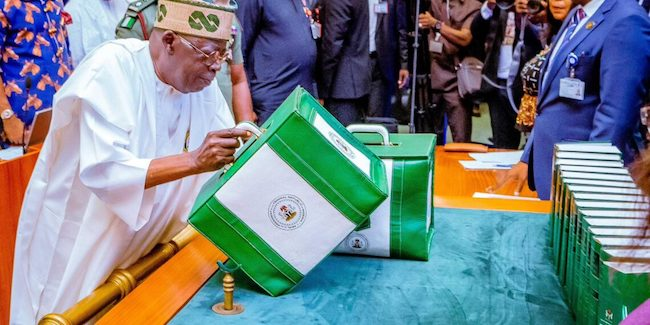•Bonny Light price averaged $71 per barrel – OPEC
•Uncertainty pervades H2’25 outlook – LCCI, BudgIT, others
By Udeme Akpan, Energy Editor
There are indications that the 2025 Federal Budget has come under funding pressures as the petroleum industry regulator, Nigerian Upstream Regulatory Commission, NUPRC, recorded significant under-performance of crude oil output in the first half of 2025, H1’25.
The budget set to be mainly funded from oil revenue, was benchmarked on 2.06 million bpd oil output, $75 per barrel and an exchange rate of N1, 500/dollar.
The NUPRC reports for the H1’25 show that the target was not met.
The breakdown in the NUPRC July 2025 ‘Crude Oil and Condensate Production’ report indicated that 1.737 million bpd, 1.671 million bpd, 1.603 million bpd, 1.683 million bpd, 1.657 million bpd and 1,697,045 were produced in January, February, March, April, May and June 2025, respectively.
Also, in the report NUPRC stated: “Lowest and peak combined crude oil and condensate production in June were 1.61 million bpd and 1.82 million bpd respectively.”
Bonny Light price hovers at $71 per barrel – OPEC
In addition to the underproduction, low crude oil prices marked the period contrary to FG’s projections as data obtained from the Monthly Oil Market Reports, MOMRs, of the Organisation of Petroleum Exporting Countries, OPEC, indicated that Nigeria’s Bonny Light traded at an average of $71.73 per barrel in June 2025.
It also indicated that the highest price of $80.14 per barrel was recorded in January 2025 while the least price of $64.55 per barrel was recorded in May 2025.
OPEC has also lamented the H1’25 global oil industry performance stating: “Crude oil prices experienced heightened volatility during H1’25, largely driven by geopolitical developments in the Middle East and Eastern Europe, as well as uncertainty surrounding US trade policy toward key economic partners.
“These developments weighed on market sentiment and contributed to fluctuating risk premiums across the oil complex. Volatility was further amplified in the oil futures market by elevated speculative activity.
“Hedge funds and other money managers frequently adjusted their net positions in response to evolving geopolitical news and signals regarding international trade policy, resulting in sharp price swings throughout the period.”
Situation may not improve in H2’ 25 – Iledare, BudgIT
However, in an interview with Financial Vanguard, Wumi Iledare, Professor Emeritus and Executive Director, Emmanuel Egbogah Foundation, Abuja, said: “I recall clearly expressing concern at the time that the budget assumptions bordered on daydreaming and were unrealistically optimistic. The key budget anchors—production volume, oil price, and costs—remain highly unpredictable, with significant deviations from the initial assumptions.
“This clearly shows that the budget process needs serious improvement. Global oil market remains very unstable. Oil prices will rise but the prices will not be stable. This will continue to impact on the implementation of the budget in the second half of 2025.”
Similarly, the Group Head of Research at BudgIT, Vahyala Kwaga, said: “These budget assumptions must be looked at in isolation of each other. This is because each of them concerns a separate aspect of the local and domestic economy.
“The oil production benchmark was not met and will likely not be met due to legacy issues in the Nigerian oil sector. Low production capacity, low maintenance of oil facilities, vandalism and oil theft still plague the sector till today.
Moreover, the foreign investments in the sector have reduced (many foreign investors have moved to the deep offshore).
“The average oil price of $75 dollars was not met (due to global conflicts and the actions of large economies) but can be met in the latter half of the year due to geopolitical factors (conflict involving Iran, increased demand from China, etc.).
“The Nigerian federal government has been advised to be pessimistic in their oil price forecasts, so as to leave room for higher revenue where the forecasts turn out to be incorrect.
“Yet, the government consistently predicts very high prices. In any case the global price of oil has little to do with the Nigerian government.
FG revenue to decline in H2’25
He also said: “The inability of all of the above to be met will mean the government will earn less than it projected.
Where this happens, the budget deficit will increase, widening the gap between revenue and expenditure. This will mean there will be less money to implement the budget and achieve public services.
“The government has the option to cut its costs, borrow or significantly improve non-oil revenues. It can decide to focus on one, two or all three. The implications are clear. Where it cuts costs, this will have an impact on government service delivery and if the right components are cut, it could reduce the deficit but the Nigerian budget is predominantly comprised of recurrent spending (debt payments, salaries and overheads).
“Where the government decides to borrow, it will further increase the deficit, leaving less money available for government services in the future. The most sustainable decision, would be if the government seeks to increase non-oil revenues.
“Where it does this fairly, efficiently and transparently, it can address the looming fiscal problems in the economy. I would advise the government to cut wasteful spending and increase non-oil revenue generation.”
Uncertainty pervades H2’25 outlook – LCCI
Director General, Lagos Chamber of Commerce and Industry, LCCI, Dr. Chinyere Almona, said: “The non-realisation in the year’s first half targets reflects deep-rooted structural and policy-related challenges.
“In the first half of 2025, oil production consistently under-performed, averaging below 1.5 million bpd when condensates are included. This was due to persistent issues such as pipeline vandalism, crude theft, under-investment, and operational inefficiencies constrain output. Unless the government accelerates security reforms in oil-producing areas, incentivizes investment in upstream assets, and fast-tracks regulatory approvals, achieving the 2.06 million bpd target in the second half remains unlikely.
“Global oil prices have fluctuated within a relatively favorable range, averaging between $70 and $67 per barrel in the year’s first half. The price of oil has remained below $75 since March to date. Geopolitical tensions and OPEC+ production management buoyed this. “Looking ahead, while the $75 benchmark is still attainable, downside risks exist, particularly from a potential global economic slowdown or increased output from non-OPEC producers.
“Price volatility will likely persist, but there is cautious optimism that this benchmark could be met or slightly exceeded.
“Lower-than-expected oil output and a volatile exchange rate could lead to substantial revenue shortfalls.
“In short, the second half of 2025 provides a narrow window to reset fiscal expectations and implement bold, realistic reforms. Bridging the gap between budget assumptions and economic realities require strong political will, policy coordination, and private sector engagement.
“The LCCI remains committed to supporting dialogue that fosters fiscal sustainability and macroeconomic resilience.”
The post 2025 budget funding under pressure as oil output under-performs in H1’25 appeared first on Vanguard News.

